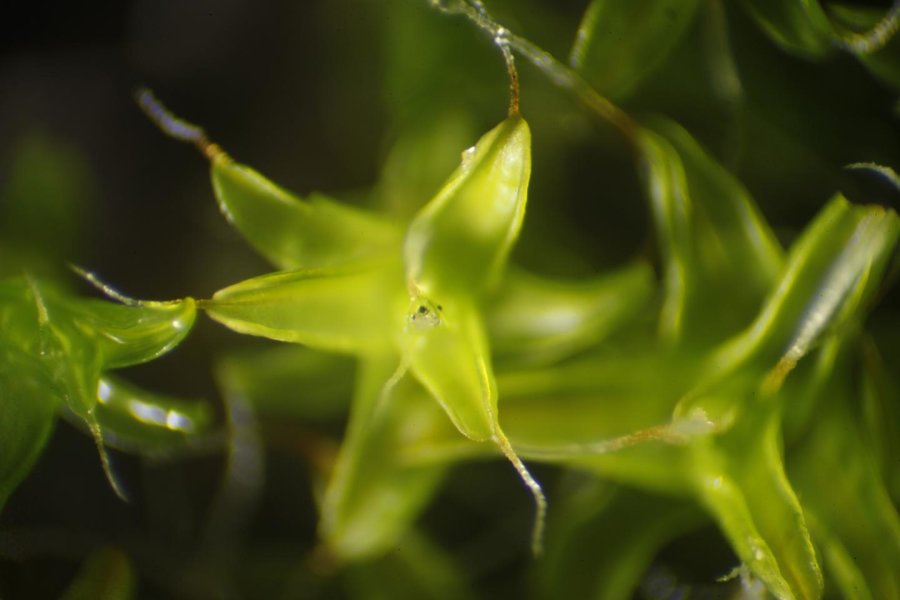This desert moss has developed the ultimate water collection toolkit
2016-07-12
https://www.sciencedaily.com/releases/2016/06/160606140006.htm

Researchers at USU and BYU describe how the leaf hair point extracts water vapor from the atmosphere using multi-scaled structures.
Credit: Tadd Truscott
Finding water in the desert is a relatively easy task for a species of moss that seems to flourish in even the most arid regions. That's according to a new study by a team of scientists and engineers who wanted to understand howSyntrichia caninervis
The findings show for the first time how the highly evolved bryophyte survives in extremely arid environments thanks in part to its specialized water collection and transportation toolkit.
The four-year-long study uncovers how the moss uses its leaves -- not roots -- to collect moisture. From molecules to raindrops,
The key to the plant's success is its small leaf hair point, or awn. These 0.5-2 mm-long hair-like structures at the tip of each leaf function like a Swiss Army knife in their ability to collect water from a variety of size scales. Whether the plant gets buckets of rain or only the occasional passing fog, the awn of S. caninervis can exploit any available water resource using four specialized tools.
Each awn is covered in nano- and micro-scale grooves where water vapor will readily condense. The grooves are just the right size and shape to condense water molecules directly from moist air and to catch microscopic fog droplets. At a larger scale, each awn also features elongated barbs that serve as collection depots where condensed or collected water forms small droplets. When large enough, the droplets move along the length of the awn toward the leaf -- sometimes at impressive speeds.
This process of water collection, droplet formation, and rapid transportation to the leaf is a critical function of the awns required to keep this moss alive.S. caninervis
At an even larger scale, the authors show, the awns themselves create a fibrous screen that helps absorb rainfall. The small plants grow in high-density clusters that form a protective cover over the desert soil. During rainfall, the plant's flexible leaves and awns absorb a majority of raindrop energy, which greatly reduces splashing and water loss.
The uniquely collaborative effort was brought to the Splash Lab by biologist Nan Wu, Ph.D. She wondered if the moss had any special water collection phenomena based on a preliminary study that she and Ye Tao had performed. Under the direction of Yuanming Zhang their efforts indicated that
The lead author, BYU mechanical engineering PhD student Zhao Pan, took the first sets of data and hypothesized that the moss was indeed using the unique nano, micro and barb-like structures to collect and transport water at various scales. With the help of BYU chemical engineering professor Bill Pitt, Zhao was able to mathematically model the energy cost of the water molecules and fog droplets, showing that the shape and size of the nano-grooves lowered the energy cost to condense water and capture fog from the atmosphere onto the awn.
The Splash Lab team, led by USU assistant professor of mechanical engineering Tadd Truscott, used high-speed video and an environmental scanning electron microscope to gather highly visual data. Their videos (use the link below) capture varying scales of water nucleation occurring in the nano-structures and the absorption of the majority of an impacting rain droplet with little or no splashing. A contrasting video, which shows rain falling on bare earth, shows how delicate desert soils without a protective layer can be washed away.
With inconsistent and limited resources in its desert environment,
"Using these different structures, this plant might get a drink every day, where other desert vegetation gets water maybe once a week," said Truscott.
As a fluid dynamics expert and engineer by trade, Truscott thinks about the practical applications to the study.
"There are several exciting angles to this research," he said. "For example, there are processes in industry where we need to extract moisture from a humid environment. It might be possible to create a man-made version of the nano- and micro-scale grooves we see in the awns and use that in a manufacturing setting."
Another connection for Truscott is the plant's remarkable anti-splash properties. For several years, he and his team have been exploring methods to reduce splashing in multiple settings, including the common urinal. The concept is no trivial topic for the Splash Lab team. They've demonstrated that urinal splash-back is a legitimate concern when it comes to public hygiene and facility maintenance costs. The way clusters of
Story Source:
The above post is reprinted from
Journal Reference:
Zhao Pan, William G. Pitt, Yuanming Zhang, Nan Wu, Ye Tao, Tadd T. Truscott.



